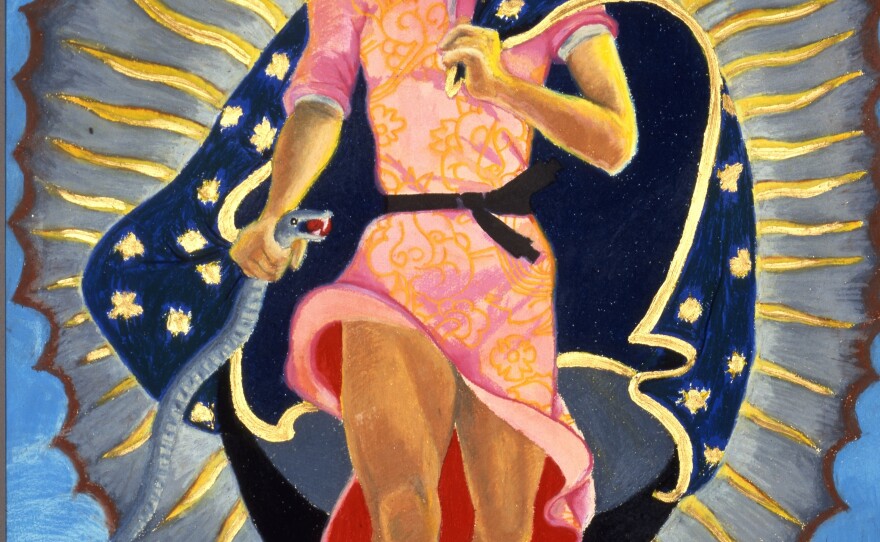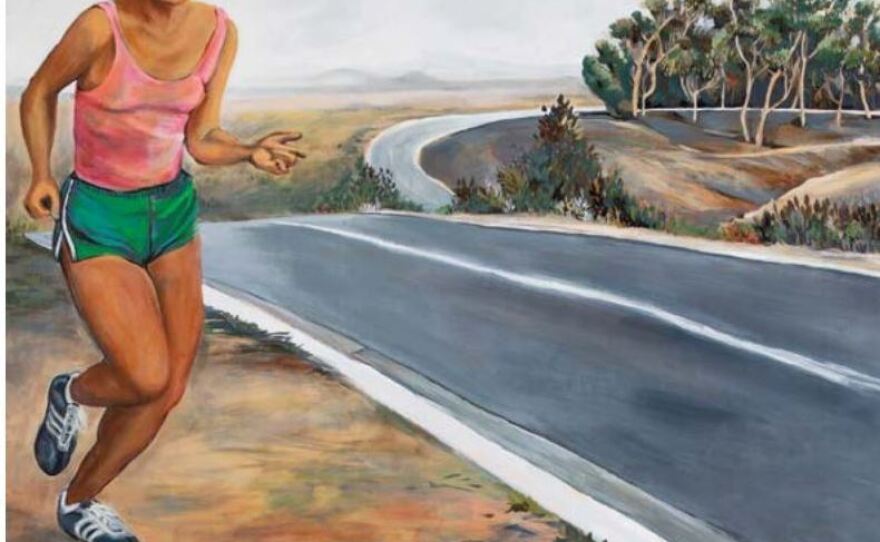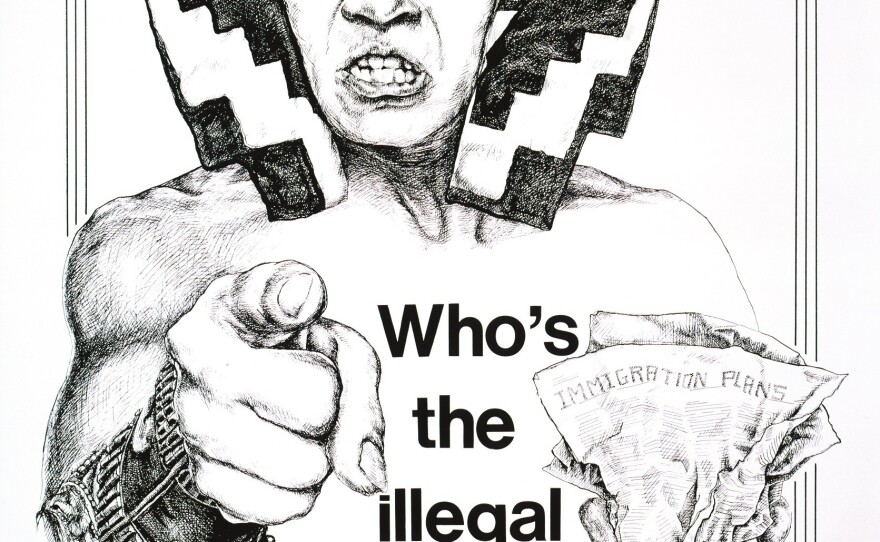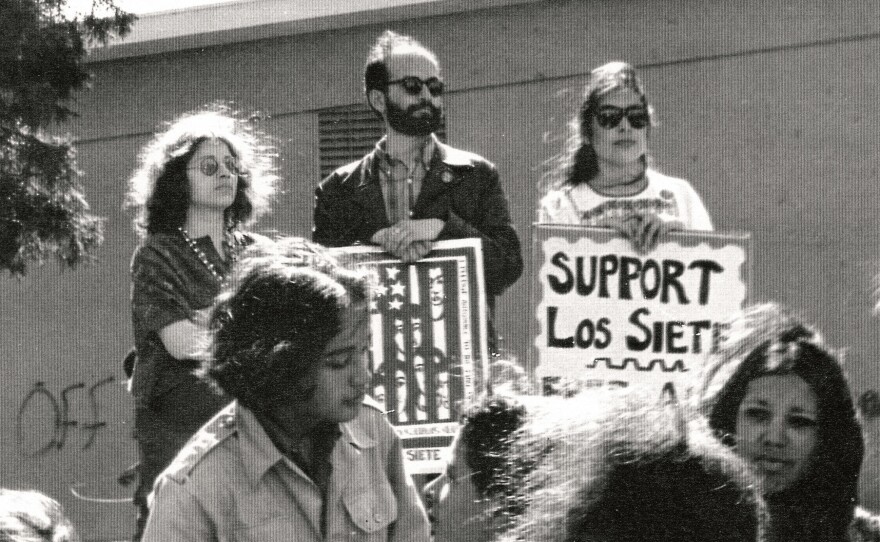Yolanda López lived to be 78 and yet that was not long enough to see her very first museum solo show.
The trailblazing, feminist Chicana artist died of cancer in her San Francisco apartment in September — a month and a half before the Museum of Contemporary Art San Diego is set to unveil a retrospective of López's influential career.
"I feel heartbroken about it," Jill Dawsey, curator of the Southern California museum, told NPR.
"It is a tragedy because she was so prolific for so long," Dawsey said, adding that "it was always a race against time."
López had been ill for several years before her death on Sept. 3 of complications of liver cancer. And Dawsey, who had a long relationship with the San Francisco-based artist, knew a solo show would need to be fast-tracked. The two began planning for the exhibition in 2019 but there were several setbacks, she explained. Chief among them was the pandemic, which slowed the conservation of many of López's most beloved works by nearly a full year.
"We always knew it was always a possibility that she might not be with us for the opening," Dawsey said. "And so the show is now opening exactly a year behind schedule."
"We wish we could have done it two months sooner," she said sadly. The show opens to the public on Saturday.

Still, Dawsey is thrilled the public will finally have the opportunity to be immersed in López's pioneering works. The exhibit will include 50 of the Mexican American artist's pieces spanning the late 1970s and 80s, including the Virgen de Guadalupe triptych that catapulted a young López into the vanguard of feminist art and which remains one of her best-known pieces.
In the first of the series — Portrait of the Artist as the Virgin de Guadalupe — López depicts herself in running shoes, bounding off a black crescent moon with Guadalupe's star-patterned mantle billowing behind her. "She's free and smiling broadly and just embodying this kind of defiant joy," Dawsey said.
Since López painted it in 1978 as part of her Master in Fine Arts Program at the University of California San Diego, it has come to "represent one of the earliest feminist reinterpretations of the Virgin of Guadalupe, which, in the following decades, became a major focus of Chicanx art and literature—owing much to the influence and prevalence of López's work," according to Dawsey.
The curator noted that another favorite message from the artist to the viewer is the title of the painting, saying that it is a tongue-in-cheek reference to James Joyce's coming of age novel, Portrait of an Artist as a Young Man.
"It is a way in which López is subverting that narrative, which is focused on a white Catholic male genius and supplants it with her own heroic vision of Chicano womanhood."
In a 2020 interview López recalled that the triptych, which celebrates working-class Chicanas of different ages, confounded her peers and professors. She has said she was the only student of color enrolled in the graduate program at the time.
The second portrait in the triptych shows her mother at a sewing machine, mending the blue and gold mantle. The third features her grandmother, as a kind of empowered goddess, enshrined by the Virgin's golden rays, holding the skin of the serpent in her lap.

Other works included in the show are dozens of López's collages, some photographs, as well as her series "¿A Dónde Vas, Chicana? Getting Through College." It is a collection of self-portraits showing her running in and around the UC San Diego campus.
The oldest of four daughters, López was born and raised in San Diego. She spent the 1960s and early 1970s in San Francisco where she went to college and became an activist in the Chicano movement, the Third World Liberation Front, and against the Vietnam War, Karen Mary Davalos told NPR.
Davalos is a professor and chair of Chicano and Latino Studies at the University of Minnesota, and wrote a book about López.
"She committed herself to social justice from a very young age," Davalos recalled. "It's in this period, on the demonstration lines, that someone tells her to bring a camera, even if it's got no film and just aim it at the cops."
The experience is what led to López's understanding "that images have power ... and that's where she developed a critical conceptual lens as an artist," the professor said.

In 1978 López also created an early version of the iconic poster featuring an Aztec man in a headdress that mimicked the Uncle Sam army recruiting poster. She made it for the Committee on Chicano Rights and it was a critical response to President Jimmy Carter's immigration plan and growing anti-immigrant sentiment.
López's version, the indigenous figure points his finger at the viewer asking, "Who's the Illegal Alien, PILGRIM?"
When providing her own thoughts behind "Three Generations: Tres Mujeres," a series of nearly 8-foot tall charcoal drawings featuring her mother, grandmother and herself that are also included in the museum exhibit, López wrote, "A common Chicano/Latino experience in contemporary American culture is the lack of positive visual representations of Latin Americans as normal, intelligent human beings. This omission and the continued use of such stereotypes as the Latin bombshell and the passive, long-suffering wife/mother negate the humanity of Raza women. The depth and breadth of our potential for moral, intellectual, spiritual, and physical courage has rarely been displayed."
She was also critical of the Western European concepts of beauty that dominate mass media and leave women who don't meet such conventions "feeling isolated and bewildered."
"People need to understand that they can be participant in the developing of a better society for all of us," she said in a 2020 interview.
While López's body of work has been widely respected among Chicano artists, leaders and scholars, it is only in the last decade or so that she has begun to get the recognition she deserves, Adriana Zavala, an associate professor in Studies in Race, Colonialism, and Diaspora at Tufts University and director of the US Latinx Art Forum, told NPR.
"Part of that has to do with the whiteness of the art world ecosystem," she said, adding that that is slowly changing.
Zavala's organization recently partnered with The Andrew W. Mellon Foundation and the Ford Foundation and the New York Foundation for the Arts to launch the Latinx Art Visibility Initiative, which includes $50,000 grants for 15 artists over the next five years. López was among those chosen in July.

López was in the final months of her life when she learned of the honor and thoughts about her own legacy were at the forefront of her mind. "This is extremely important especially since my generation is beginning to die," López told Mission Local in an interview.
She said she planned to use the money to organize her life's work into an archive that can serve as an educational tool.
The aim of the fellowship is to increase visibility around Latinx artists beyond the word of Chicano or Latinx art, and into more mainstream culture. Often, Zavala said, López and the other artists selected "are misunderstood as betwixt and between."
"Are they American artists or are they Latin American artists? We really focus on bringing public understanding to the fact that these are American artists, but they often are rendered invisible within the rubrics and the structures of the art world," according to Zavala.
Over years of friendship with the artist, Zavala said it was clear that López, even from her early days was most interested "in a value for a creative expression that is beyond outside of kind of gallery and museum world."
It was a value system that appeared to stay with her through the very end. After learning about the fellowship she said was most grateful that it wasn't a competitive type of award.
"That's the great joy, that I didn't have to compete with anyone else. They accepted me on my own terms," she said.
Copyright 2022 NPR. To see more, visit https://www.npr.org. 9(MDAzMjM2NDYzMDEyMzc1Njk5NjAxNzY3OQ001))







